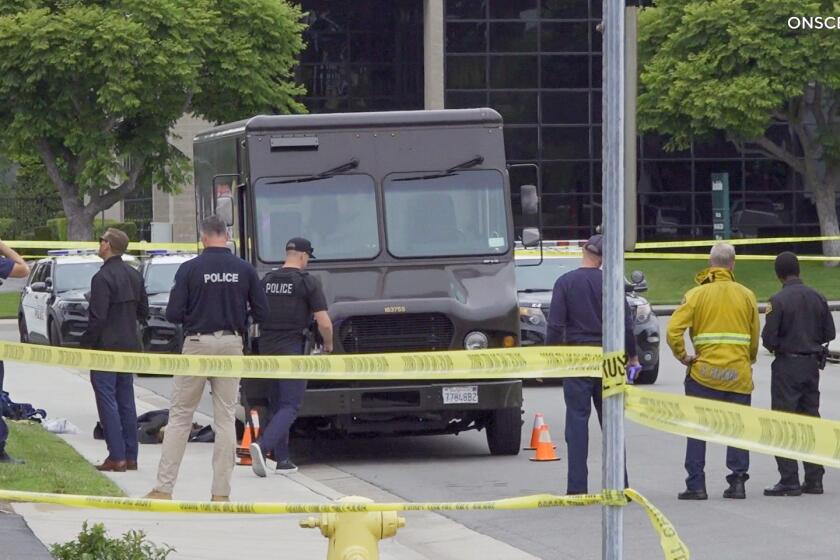Standard Set on Release of Rapists
The California Supreme Court made it tougher Thursday for serial sex offenders to win release from state mental hospitals.
The state high court, acting in the case of serial rapist Patrick Ghilotti, established a legal standard that will allow judges to keep sexually violent predators locked up if two state-appointed mental health experts determine that the inmate presents a “substantial danger” to society.
This will permit the state to commit offenders who are deemed to have less than a 50% chance of attacking again, the court ruled. Defense attorneys had argued that offenders should be released from state hospitals unless they were more likely than not to rape or molest again.
At issue was the meaning of a 1996 California law that allows the state to commit repeat sex offenders after completion of their prison terms if the felons are “likely” to commit sexual violence again.
The ruling will affect hundreds of sex criminals who have been locked up in California mental hospitals. It also will give the state a second chance to keep Ghilotti confined to Atascadero State Hospital.
Ghilotti, 46, was set to be freed in Marin County in December after three mental health experts found that he was not “likely” to reoffend. A Marin County judge and a Court of Appeal refused to stop his release, but the state high court intervened.
In its 5-2 ruling Thursday, the court said that Marin County Superior Court Judge John S. Graham should again review Ghilotti’s case to determine whether his psychological evaluators complied with its new “substantial danger” standard.
If the judge determines that the evaluators failed to consider whether Ghilotti remains a “substantial danger,” the reports will have to be redone and reviewed a second time.
Justice Marvin Baxter, writing for the court majority, defined substantial danger as “a serious and well-founded risk.”
That “does not mean that the risk of reoffense must be higher than 50%,” Baxter wrote in People vs. Ghilotti, S102527.
At the same time, the court said evaluators also may take into account promises by the inmate to undergo therapy and take drugs to diminish his sex drive.
Justice Kathryn Mickle Werdegar, who filed a separate opinion in the case, agreed that a judge should review Ghilotti’s evaluations, but objected to the new standard of “substantial danger.”
She said people should not be deprived of their liberty after serving prison terms unless they are found to have greater than a 50% likelihood of reoffending. She warned that the ruling may make California’s 1996 sex predator law vulnerable to a constitutional challenge if it is appealed to the U.S. Supreme Court.
Almost any sex offender, regardless of his potential for future violence, could be construed as likely to reoffend under the court’s new standard, she said.
“While one clearly may prefer a scheme that confines all or nearly all sexually violent predators beyond completion of their sentences--the effective result of the majority’s interpretation, despite its protests to the contrary--that is not the scheme the Legislature chose,” she wrote.
Thursday’s decision was the first to clarify the meaning of California’s Sexually Violent Predator Act, one of at least 15 similar laws across the nation that permit repeat sex offenders to be committed to mental institutions after prison.
The act says the state may commit these offenders if they had multiple victims and if at least two mental health experts determine that their mental disorder makes them “likely” to attack again unless confined and treated.
Although the Legislature failed to define the meaning of “likely,” the court’s determination that it means a “substantial danger” is consistent with the law’s purpose, Baxter wrote.
“That purpose is to protect the public,” he wrote.
The decision also for the first time clarified that trial judges may review the evaluators’ reports and reject them, and that the psychologists or psychiatrists who write the recommendations may consider the fact that the inmate will continue to receive treatment for sexual misconduct after being returned to the community.
The state high court took the case on an emergency petition in December. Gov. Gray Davis and Atty. Gen. Bill Lockyer asked the high court to intervene and give the state’s director of mental health the power to override recommendations by psychological evaluators.
The court rejected that approach. “This is not a plausible reading of the statute,” Baxter wrote.
But Gov. Davis said Thursday that he was pleased with the court’s ruling. “I am convinced Mr. Ghilotti should remain locked up, and I applaud the high court’s wisdom in ensuring that proceedings to recommit him can now go forward,” Davis said.
Davis recently backed a bill that would have allowed the director of the Department of Mental Health to keep a sex offender in a hospital, regardless of the recommendations of mental health evaluators. The legislation failed.
Justices Carlos R. Moreno and Janice Rogers Brown dissented in Thursday’s ruling, contending that the court could not require Marin County Judge Graham to review Ghilotti’s psychological evaluations because the issue was not technically before the court.
Moreno pointed out that the state Department of Mental Health and Marin County prosecutors had failed to ask for such a review last year. To order Graham to review the reports now would be appropriate only if the judge had erred, he said. “The Superior Court in the present case did not err,” Moreno wrote.
Moreno, whose opinion was signed by Brown, favored the standard set by the court for determining future danger, but he also amplified on it.
He said the law requires “not just a risk of reoffense, but a high risk of reoffense.”
“The risk of reoffense should be sufficiently high to distinguish the ‘small but extremely dangerous group of sexually violent predators’ at which the act is aimed from the general population of convicted violent sex offenders, all of whom pose an elevated risk of recidivism,” Moreno wrote.
Frank J. Cox, chief deputy public defender for Marin County, said the court’s new standard will probably make it easier to commit sex offenders to state hospitals after prison and to keep them in for long periods. But he said he was glad that Ghilotti still has a chance at freedom, and will not decide whether to appeal until Ghilotti’s fate is known.
“With good fortune, Marin County will release Patrick Ghilotti and we will be on our way,” he said.
Cox said Ghilotti “should be released,” but declined to speculate on whether the trial court will determine that his evaluators complied with the new standard.
Ghilotti has been convicted of four rapes, and has admitted to six others. After serving a 12-year prison term for the most recent rape, he was committed to Atascadero, where he has spent the last four years.
Stephen Mayberg, director of California’s Department of Mental Health, said he was pleased that the court had provided a uniform standard for evaluating predators.
He noted that the department believes Ghilotti could be released safely if he were subject to certain conditions, such as mandated therapy and drugs to reduce his sex drive. Ghilotti would have been returned to Marin County without any supervision if the state Supreme Court had not acted.
Chief Assistant Atty. Gen. Robert R. Anderson, who has been fighting to keep Ghilotti confined, said he was “pretty happy” with the decision.
“I think it is a decision that advances public safety within the state,” Anderson said. “I think it will allow evaluators to make a more reasoned assessment without being misguided by some type of belief that a mathematical evaluation is required.”
*
Times staff writers John Glionna and Miguel Bustillo contributed to this report.
More to Read
Start your day right
Sign up for Essential California for news, features and recommendations from the L.A. Times and beyond in your inbox six days a week.
You may occasionally receive promotional content from the Los Angeles Times.







